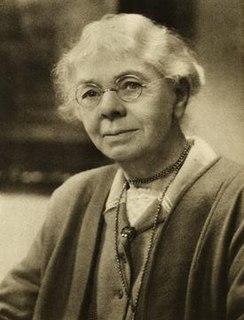
Larix kaempferi, the Japanese larch or karamatsu in Japanese, is a species of larch native to Japan, in the mountains of Chūbu and Kantō regions in central Honshū.

Sir William Turner Thiselton-Dyer was a leading British botanist, and the third director of the Royal Botanic Gardens, Kew.

Frederick William Thomas Burbidge was a British explorer who collected many rare tropical plants for the famous Veitch Nurseries.
Lilian Suzette Gibbs (1870–1925) was a British botanist who worked for the British Museum in London and an authority on mountain ecosystems.

The Botanical Magazine; or Flower-Garden Displayed, is an illustrated publication which began in 1787. The longest running botanical magazine, it is widely referred to by the subsequent name Curtis's Botanical Magazine.
The Victoria Medal of Honour (VMH) is awarded to British horticulturists resident in the United Kingdom whom the Royal Horticultural Society Council considers deserving of special honour by the Society.
Ellen Hutchins (1785–1815) was an early Irish botanist. She specialised in seaweeds, lichens, mosses and liverworts. She is known for finding many plants new to science, identifying hundreds of species, and for her botanical illustrations in contemporary publications. Many plants were named after her by botanists of the day.

The Veitch Memorial Medal is an international prize issued annually by the Royal Horticultural Society (RHS).

Walter Hill (1820–1904) was the first curator of the Brisbane Botanic Gardens at Gardens Point in Brisbane, Australia.

Anne Elizabeth Ball (1808–1872) was an Irish botanist, amateur algologist, and botanical illustrator. Born in Cobh 1808, Ball was a sister of naturalist Robert Ball (1802–1857) and zoologist Mary Ball (1812–1898). The siblings became interested in natural history through the passion of their father, Bob Stawell Ball.
Herbert Cowley was a British botanist, gardener, garden photographer and garden writer who edited The Garden journal from 1915 to the mid-1920s. He wrote many gardening books until retiring in 1936.

Lilian Snelling (1879–1972) was "probably the most important British botanical artist of the first half of the 20th century". She was the principal artist and lithographer to Curtis's Botanical Magazine between 1921 and 1952 and "was considered one of the greatest botanical artists of her time" – "her paintings were both detailed and accurate and immensely beautiful". She was appointed MBE in 1954 and was awarded the Victoria Medal in 1955. The standard author abbreviation Snelling is used to indicate this person as the author when citing a botanical name.
Maria Elizabetha Jacson was an eighteenth-century English writer, as was her sister, Frances Jacson (1754–1842), known for her books on botany at a time when there were significant obstacles to women's authorship. In some sources her name appears as Maria Jackson, Mary Jackson or Mary Elizabeth Jackson. She spent most of her life in Cheshire and Derbyshire, where she lived with her sister following her father's death.

Eliza Pickrell Routt (1839–1907) was a pioneer in women's suffrage and the original first lady of the state of Colorado.
Mary Anderson Grierson was a Welsh-born Scottish botanical artist and illustrator. The youngest of three children to parents hailing from Dumfries, she was encouraged by her mother to paint from an early age but preferred watercolour over oil. Grierson served in the Women's Auxiliary Air Force as a flight officer in a photographic reconnaissance unit and used the skills she learnt into use later in her life. She joined De Havilland's public relations department after demobilisation and moved to Hunting Aerosurveys in 1947. Grierson was sent on a week course in pen and ink drawing in Suffolk ten years later and returned there for another ten years after finding the experience fulfilling.
Olive Mary Edmundson was a British horticulturalist who was denied a scholarship at the Royal Horticultural Society Garden in 1898.
Swanley Horticultural College, founded in 1889, was a college of horticulture in Hextable, Kent, England. It originally took only male students but by 1894 the majority of students were female and it became a women-only institution in 1903.
Madeline Agnes Agar was a British landscape designer. She was an early professional female landscape designer in Britain, and responsible for the design and the layout of a number of public gardens across London in the early 20th-century. She was the second woman to be the landscape gardener for the Metropolitan Public Gardens Association and was an author of books on gardening.

Ann Lee was a British botanical illustrator who also illustrated birds and insects.

Alice Hutchins was one of the two first women gardeners hired at Kew Gardens in 1896.











